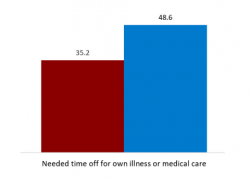
In February we celebrate both Black History Month and the anniversary of the Family and Medical Leave Act’s passage into law. It is fitting that the FMLA anniversary falls in Black History Month as Black workers had some of the lowest rates of confidence in their access to paid sick leave during the first year of the pandemic. While COVID has had a considerable impact on all workers, women, and especially women of color, have suffered a disproportionate economic toll given weak supports – like lower access to job-protected, paid leave.
The FMLA allows eligible workers who need to focus on their own medical care or the care of a loved one to have up to 12 weeks of unpaid job-protected leave during a 12-month period. In 1993, when President Clinton first signed the FMLA into law, it was a historic first step in recognizing the need for people to be able to take time off work to care for themselves and their loved ones without fear of losing their job. But the road there had not been easy, or quick.
States started passing their own job-protected leave laws in the 1980s, and the first version of the FMLA was drafted during the Reagan administration. That bill passed through Congress with bipartisan support for the first time in 1991, but was vetoed by President George H.W. Bush. When President Clinton took office in 1993, it was the first piece of legislation he signed into law.
The FMLA was a monumental first step. Because of eligibility rules, however, the FMLA only guarantees some workers the right to unpaid leave. In most instances, workers only get paid if their employer voluntarily provides it. While all workers have care obligations – whether for themselves or their family members – women are more likely to need leave, more likely to have an unmet need for leave, and are less likely to receive pay while on leave if they can take it.
One reason we know those statistics is because of large-scale, nationally representative surveys of workers and employers that the Department of Labor has been fielding regularly since 1995. These surveys, the most recent of which was fielded in 2018 by our Chief Evaluation Office, provide an important picture of FMLA coverage, knowledge, access and perceptions across workers and employers. In doing so, these surveys help us to understand the law’s reach, but also its limits.
For instance, those surveys show that about 56% of the workforce is eligible for FMLA leave, with women, Hispanic workers, mixed-race workers, single parents, and workers with lower levels of formal education being less likely to be eligible. These surveys also show important gaps in workers’ knowledge about the law, with more workers thinking that they are covered by the law than are covered in practice.
These surveys also document cases where workers needed to take leave but did not, a more common problem for women, single parents, workers with a high school degree or less, and workers of color. The most common reason for not taking leave was that workers could not afford to take unpaid leave from work. As a result, these surveys show both the importance of FMLA protections for workers, but also their spotty coverage, especially for workers who cannot afford to take unpaid leave to cover an emergency.
The FMLA remains the only federal law that offers protection for private sector employees who need time away from work to manage their own health or care for a loved one. Nearly three decades later, President Biden has proposed a plan to offer paid family and medical leave. Studies show that access to paid leave improves child health and well-being, maternal health, families’ economic security, worker retention, labor force participation, and worker productivity and morale.
It is time for the next chapter in U.S. labor law and protections. An equitable economic recovery means prioritizing the needs and experiences of the most vulnerable people in our society and our workforce. Creating a national paid family and medical leave program is one important way to do just that, and decades of research documents the need for such a program and how it should be designed.
Gayle Goldin and Sarah Jane Glynn are senior advisors in the U.S. Department of Labor’s Women’s Bureau. Alex Hertel-Fernandez is the department’s deputy assistant secretary for research and evaluation. Follow the Women’s Bureau on Twitter: @WB_DOL.

 U.S. Department of Labor Blog
U.S. Department of Labor Blog



